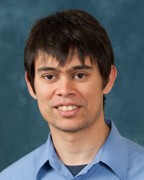Keynote Presentations
 
KN1 - Gil Ast
Chair, Department of Human Molecular Genetics & Biochemsitry
Sackler Medical School
Tel Aviv University, Israel
website: http://www.tau.ac.il/~gilast/
Presentation Title: How Chromatin organization and epigenetics talk with alternative splicing
Presentation Time: Sunday, July 21 9:00 AM - 10:00AM
Room: Hall 1
 
Abstract
The importance of RNA and chromatin in the multiple levels of regulation that ensure proper functioning of the eukaryotic transcriptome and proteome has been increasingly recognized in recent years. Converging lines of evidence have led to a clearer realization that many of these processes are interrelated. For example, there is continuous feed-forward crosstalk among the processes of chromatin organization, transcription, and pre-mRNA splicing. Furthermore, it has now become apparent that chromatin structure and epigenetic markers influence the recognition of exons and splice site choices. The multiple layers of regulation that function jointly in chromatin organization, transcription, and RNA processing will be presented.
 
The Ast's Group
Alternative splicing is a mechanism by which more than one mRNA transcripts are generated from the same mRNA precursor. Recent findings suggest that almost all the human genes undergo alternatively spliced, and we demonstrated that humans contain the highest level of alternative splicing. Alternative splicing can be specific to tissue type, environment or developmental stage. Splice variants have also been implicated in various diseases including cancer. Detection of these variants will enhance our understanding of the complexity of the human genome and provide disease-specific and prognostic biomarkers. Our group has made seminal contributions to our understanding of the complexity in genomic expression through alternative mRNA splicing and the involvement of this process in genetic disorders and cancer.
The broad focus of our research is on pre-mRNA splicing regulation and the importance of alternative splicing in generating transcriptomic diversity unique to our species. We also study the potential link between DNA packaging and splicing, and are interested in the effects nucleosomal positioning, specific histone modifications and other epigenetic characteristics have on pre-mRNA processing. An increasing body of evidence indicates that transcription and splicing are coupled and it is accepted that chromatin organization and DNA modification regulate transcription. Little is known, however, about the cross-talk between chromatin structure and splicing. We also study splicing-related genetic diseases like the neurodegenerative disease Familial Dysautonomia and the link between splicing and various cancer types. Finally, we study the role splicing plays in microRNA (miRNA) regulation as well.
 
 
Center for Statistical Genetics, Department of Biostatistics,
University of Michigan School of Public Health, United States
website: http://www.sph.umich.edu/csg/abecasis/
Presentation Title: Insights from Sequencing Thousands of Human Genomes
Presentation Time: Sunday, July 21 4:35 PM - 5:35 PM
Room: Hall 1
 
 
Abstract:
Identifying and characterizing the genetic variants that affect human traits is one of the central objectives of human genetics. Ultimately, this aim will be achieved by examining the relationship between interesting traits and the complete genome sequences of many individuals. Whole genome re-sequencing of thousands of individuals remains challenging, but advances in laboratory methods and in statistical methodology have resulted in substantial progress in our understanding of complex disease biology.
Here, we discuss results of the first generation of large scale sequencing studies. I illustrate findings from analysis of sequence data in 1,000s of individuals and, in particular, on the insights from two studies where my group is actively involved, a case-control study of age-related macular degeneration and an ongoing population sequencing study in the island of Sardinia. Along the way, I will highlight analytical challenges and opportunities posed by next-generation sequence data - ranging from methods for the analysis of low-coverage data, to strategies for estimating individual ancestry using sequence data, to methods for combining the results of sequencing studies across samples.
 
Biography:
Gonçalo Abecasis is the Felix Moore Collegiate Professor of Biostatistics at the University of Michigan School of Public Health, where he has been a faculty member since 2001. He has a Ph.D. in Human Genetics from the University of Oxford, where he worked with William Cookson and Lon Cardon.
Dr. Abecasis' research focuses on the development of statistical tools and computational methods that enable studies of genetic variation and its connections to human disease. Software and algorithms developed by Dr. Abecasis are used in human genetic studies around the world. He has made important contributions to our understanding of patterns of genetic variation across the genome, its relationship to a variety of complex traits and diseases, and developed algorithms that enable analysis of large challenging datasets. He is currently deploying next-generation sequencing technologies to study the genomes of thousands of individuals.
 
The importance of RNA and chromatin in the multiple levels of regulation that ensure proper functioning of the eukaryotic transcriptome and proteome has been increasingly recognized in recent years. Converging lines of evidence have led to a clearer realization that many of these processes are interrelated. For example, there is continuous feed-forward crosstalk among the processes of chromatin organization, transcription, and pre-mRNA splicing. Furthermore, it has now become apparent that chromatin structure and epigenetic markers influence the recognition of exons and splice site choices. The multiple layers of regulation that function jointly in chromatin organization, transcription, and RNA processing will be presented.
The Ast's Group
Alternative splicing is a mechanism by which more than one mRNA transcripts are generated from the same mRNA precursor. Recent findings suggest that almost all the human genes undergo alternatively spliced, and we demonstrated that humans contain the highest level of alternative splicing. Alternative splicing can be specific to tissue type, environment or developmental stage. Splice variants have also been implicated in various diseases including cancer. Detection of these variants will enhance our understanding of the complexity of the human genome and provide disease-specific and prognostic biomarkers. Our group has made seminal contributions to our understanding of the complexity in genomic expression through alternative mRNA splicing and the involvement of this process in genetic disorders and cancer.
The broad focus of our research is on pre-mRNA splicing regulation and the importance of alternative splicing in generating transcriptomic diversity unique to our species. We also study the potential link between DNA packaging and splicing, and are interested in the effects nucleosomal positioning, specific histone modifications and other epigenetic characteristics have on pre-mRNA processing. An increasing body of evidence indicates that transcription and splicing are coupled and it is accepted that chromatin organization and DNA modification regulate transcription. Little is known, however, about the cross-talk between chromatin structure and splicing. We also study splicing-related genetic diseases like the neurodegenerative disease Familial Dysautonomia and the link between splicing and various cancer types. Finally, we study the role splicing plays in microRNA (miRNA) regulation as well.
KN3 - Lior Pachter
Department of Mathematics, Molecular & Cell Biology and Electrical Engineering & Computer Science
University of California, Berkeley, United States
website: http://math.berkeley.edu/~lpachter/
Presentation Title: Sequencing based functional genomics (analysis)
Presentation Time: Monday, July 22, 9:00 AM - 10:00 AM
Room: Hall 1
Additional Information:
 
Abstract:
Sequence census methods couple high-throughput DNA sequencing to biochemical assays and are transforming standard functional genomics assays into powerful genome-wide probes of biochemical activity. We will survey the plethora of *-Seq assays that have been developed and describe examples of how computational advances are going hand-in-hand with the biotechnology to enable biological discovery.
Biography
I am a computational biologist working in genomics. My career began in comparative genomics, and initially I was interested in genome alignment, annotation, and the determination of conserved regions using phylogenetic methods. I contributed to the mouse, rat, chicken and fly genome sequencing consortia, and the ENCODE project. More recently I've become focused on functional genomics, which includes answering questions about the function and interaction of DNA, RNA and protein products. I'm particularly interested in applications of high-throughput sequencing to RNA biology.
I'm also interested in algorithms, statistical methodology, and mathematical foundations for computational genomics. These interests are reflected in my appointments across different departments and colleges: Mathematics, Molecular & Cell Biology, and Electrical Engineering & Computer Science. My group includes students and postdocs from Computer Science, Mathematics, Bioengineering, Molecular and Cell Biology and Statistics.
 
KN4 - Gary Stormo
Department of Genetics, Center for Genome Sciences and System Biology
Washington University in St. Louis, School of Medicine, United States
website: http://stormo.wustl.edu/
Presentation Title: Searching for Signals in Sequences
Presentation Time: Monday, July 22, 4:35 - 5:35
Room: Hall 1
Additional Information: Show/Hide
 
Abstract
DNA is an information carrying molecule, encoding not only for the RNAs and proteins that perform the functions necessary for cellular and organismal viability, but also encoding the instructions for when, where and under what conditions those functional molecules are expressed. Most of my career has been devoted to studying the signals, cis-regulatory elements, in DNA and RNA that controls various aspects of gene expression. This talk will provide some background on the nature of the signals we seek, some history of approaches to find them, how current technology facilitates the search and where I think the field is headed.
Biography
Gary Stormo is the Joseph Erlanger Professor in the Department of Genetics and the Center for Genome Sciences and Systems Biology at Washington University School of Medicine in St Louis. He received his B.S. degree in biology from the California Institute of Technology and his and Ph.D. in molecular biology from the University of Colorado at Boulder. He remained at the University of Colorado as a faculty member in the Department of Molecular, Cellular and Developmental Biology until joining the faculty at WUSM in 1999. Beginning with his graduate thesis work he has combined experimental and computational approaches to understanding gene regulation. Most of that work has focused on identifying, modeling and predicting regulatory sites in DNA and RNA and their contributions to regulatory networks that control gene expression in vivo.
 
 
KN5 - Carole Goble
Department of Computer Science
University of Manchester, United Kingdom
website: http://www.cs.man.ac.uk/~carole/index.html
Presentation Title: Results may vary: what is reproducible? why do open science and who gets the credit?
Presentation Time: Tuesday, July 23, 9:00 AM - 10:00 AM
Room: Hall 1
Additional Information: Show/Hide
 
Abstract
How could we evaluate research and researchers? Reproducibility underpins the scientific method: at least in principle if not practice. The willing exchange of results and the transparent conduct of research can only be expected up to a point in a competitive environment. Contributions to science are acknowledged, but not if the credit is for data curation or software. From a bioinformatics view point, how far could our results be reproducible before the pain is just too high? Is open science a dangerous, utopian vision or a legitimate, feasible expectation? How do we move bioinformatics from one where results are post-hoc "made reproducible", to pre-hoc "born reproducible"? And why, in our computational information age, do we communicate results through fragmented, fixed documents rather than cohesive, versioned releases? I will explore these questions drawing on 20 years of experience in both the development of technical infrastructure for Life Science and the social infrastructure in which Life Science operates.
Biography
Carole Goble is a full professor in Computer Science at the University of Manchester, UK. She has an international reputation in Semantic Web, Distributed computing, and Social Computing for scientific collaboration. She is a member of the Software Sustainability Institute UK. She directs the myGrid project, which produces the widely-used open source Taverna workflow management system; myExperiment, a social web site for sharing scientific workflows; the Biocatalogue of web services for the life sciences; and the SEEK for storing, sharing and preserving Systems Biology outcomes.
In 2008 Carole was awarded the inaugural Microsoft Jim Gray award for outstanding contributions to e-Science. In 2010 she was elected a Fellow of the Royal Academy of Engineering. In 2012 she was nominated for the Benjamin Franklin award for open science in Biology.
2013 ISCB Accomplishment by a Senior Scientist Award
KN6 - David Eisenberg
UCLA-DOE Institute and Howard Hughes Medical Institute
UCLA, Los Angeles, CA
website: http://www.doe-mbi.ucla.edu/people/eisenberg
Presentation Title: Protein Interactions in Health and Disease
Presentation Time: Tuesday, July 23, 4:35 PM - 5:35 PM
Room: Hall 1
Additional Information: Show/Hide
 
Abstract:
To aid research on proteins and metabolism, we have set up several databases and servers, all available at www.doe-mbi.ucla.edu. One is the Database of Interacting Proteins (DIP), a curated collection of experiments on protein interactions. Another is ProLinks, a collection of functional linkages between proteins in many organisms, inferred from whole genome sequences. A third is ZipperDB, a database containing predictions of fibril-forming proteins identified by the 3D Profile Method.
ZipperDB has enabled our efforts to determine more than 100 atomic structures of the ‚Äėsteric zipper‚Äô spines of amyloid fibers. These fibers are associated with dozens of fatal diseases, as well as numerous evolved protein functions. Knowledge of these atomic structures has permitted the design of inhibitors of formation of fibers involved in Alzheimer‚Äôs Disease, HIV, and cancer.
Biography
As a Harvard undergraduate, David Eisenberg had the good fortune to be assigned to study with John T. Edsall, one of the pioneers of protein chemistry, who oriented him to his life’s work. As a Rhodes Scholar at Oxford, Eisenberg earned a D.Phil. in theoretical chemistry for study with Charles Coulson on hydrogen bonding in ice. Returning to the States, Eisenberg worked as a postdoctoral fellow with Walter Kauzmann, the discoverer of the hydrophobic interaction. Together they wrote a monograph, The Structure and Properties of Water, still in print after 44 years. In further postdoctoral study at Caltech, Eisenberg learned X-ray crystallography. Since 1969, Eisenberg has been on the faculty of UCLA, now as the Paul D. Boyer Professor of Biochemistry and Molecular Biology, Investigator of the Howard Hughes Medical Institute, and Co-Director of the Center for Global Mentoring. Eisenberg now concentrates on proteins in the amyloid state. He has coauthored a text Physical Chemistry for Students of the Life Sciences, as well as some 350 research papers and reviews, with over 50,000 Google Scholar citations.



